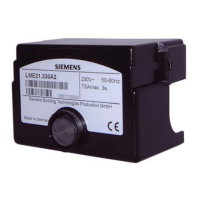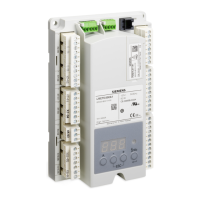3/25
Building Technologies CC1N7101en
HVAC Products 27.11.2008
Installation notes
• Always run the high ignition cables separate from the unit and other cables while
observing the greatest possible distance
• Do not mix up live and neutral conductors
• Install switches, fuses, earthing, etc., in compliance with local regulations
• The connection diagrams show the burner controls with earthed neutral conductor.
In networks with non-earthed neutral conductor and ionization current supervision,
terminal 2 must be connected to the earth conductor via an RC unit (type reference
ARC 4 668 9066 0). It must be made certain that local regulations are complied
with (e.g. protection against electric shock hazard) since AC 120 V (50 / 60 Hz) or
AC 230 V (50 / 60 Hz) mains voltage produces peak leakage currents of 2.7mA
• Make certain that the maximum permissible current rating of the connection termi-
nals will not be exceeded
• Do not feed external mains voltage to the control outputs of the unit. When testing
the devices controlled by the burner control (fuel valves, etc.), the LME… must not
be connected
• In the case of burners with no fan motor, an AGK25 must be connected to terminal
3 of the unit, or else the burner cannot reliably be started up
• For safety reasons, feed the neutral conductor to terminal 2. Connect the burner
components (fan, ignition transformer and fuel valves) to the neutral distributor as
shown below in figure. The connection between neutral conductor and terminal 2 is
prewired in the base
Example
23
7
4
5
BV2
BV1
Z
M
N
7101a05/0804
Correct wiring of neutral conductors!
Electrical connection of flame detectors
It is important to achieve practically disturbance- and loss-free signal transmission:
• Never run detector cables together with other cables
– Line capacitance reduces the magnitude of the flame signal
– Use a separate cable
• Observe the permissible length of the detector cables (refer to «Technical data»)
• The ionization probe is not protected against electric shock hazard
• Locate the ignition electrode and the ionization probe such that the ignition spark
cannot arc over to the ionization probe (risk of electrical overloads) and that it can-
not adversely affect the supervision of ionization
• Insulation resistance
– Must be a minimum of 50 MΩ between ionization probe and ground
– Soiled detector holders reduce the insulation resistance, thus supporting cree-
page currents
• Earth the burner in compliance with the relevant regulations; earthing the boiler
alone does not suffice
Legend
BV... Fuel valve
M Fan motor
Z Ignition transformer

